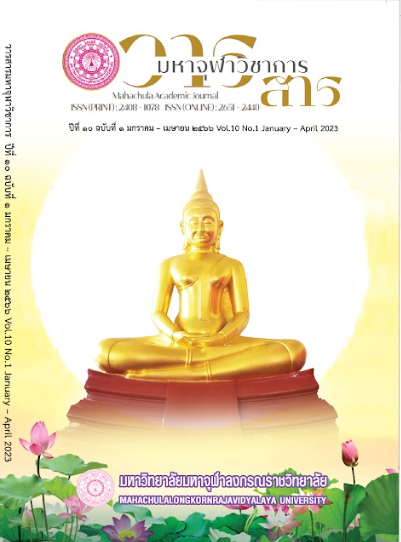Learning Management in the 21st Century of Charity Schools in Buddhist Temples
Main Article Content
Abstract
Charity schools in Buddhist temples are one type of educational management that falls under the Office of the Private Education Commission, with learning activities based on the Ministry of Education's curriculum. Charity schools provide students with opportunities for academic learning as well as moral training based on Buddhist teachings in order to develop desirable characteristics. Students are cultivated to be knowledgeable, capable, and moral in the 21st century. Charity schools in Buddhist temples also enhance students' potential by utilizing digital and media technology to support learning management, including the use of tools that connect to the internet system. This results in numerous changes in the educational system, such as smart classrooms, E-learning systems, and so on. It is necessary to develop personnel with the knowledge and techniques to manage learning effectively so that students can achieve learning objectives and apply their learning experiences in their daily lives.
Article Details

This work is licensed under a Creative Commons Attribution-NonCommercial-NoDerivatives 4.0 International License.
References
กุลิสรา จิตรชญาวณิช. การจัดการเรียนรู้. กรุงเทพมหานคร: สำนักพิมพ์จุฬาลงกรณ์มหาวิทยาลัย, ๒๕๖๒.
คณะอนุกรรมการปฏิรูปการเรียนรู้. ปฏิรูปการเรียนรู้ ผู้เรียนสำคัญที่สุด. กรุงเทพมหานคร: สำนักงานคณะกรรมการการศึกษาแห่งชาติ, ๒๕๔๓.
คณาจารย์. กลุ่มและสมาคมโรงเรียนการกุศลของวัดในพระพุทธศาสนา. ปราจีนบุรี: โรงพิมพ์ หจก.เจตนารมณ์ภัณฑ์, ๒๕๕๓.
ณิรดา เวชญาลักษณ์. หลักการจัดการเรียนรู้. กรุงเทพมหานคร: โรงพิมพ์แห่งจุฬาลงกรณ์มหาวิทยาลัย, ๒๕๖๑.
ประไพ ฉลาดคิด. หลักการสอน. กรุงเทพมหานคร: เกษมศรี ซี.พี., ๒๕๔๘.
พิมพันธ์ เดชะคุปต์และพเยาว์ ยินดีสุข. การจัดการเรียนรู้ในศตวรรษที่ ๒๑. กรุงเทพมหานคร: โรงพิมพ์แห่งจุฬาลงกรณ์มหาวิทยาลัย, ๒๕๕๗.
ไพฑูรย์ สินลารัตน์. ทักษะแห่งศตวรรษที่ ๒๑ : ต้องก้าวให้พ้นกับดักของตะวันตก. กรุงเทพมหานคร: จุฬาลงกรณ์มหาวิทยาลัย, ๒๕๕๗.
มหาวิทยาลัยราชภัฏวไลยอลงกรณ์ ในพระบรมราชูปถัมภ์. คู่มือการจัดระบบการเรียนการสอนที่ยึดผู้เรียนเป็นศูนย์กลางการเรียนรู้. กรุงเทพมหานคร: โรงพิมพ์เทียนวัฒนา พริ้นท์ติ้ง, ๒๕๕๓.
ราชกิจจานุเบกษา. รัฐธรรมนูญแห่งราชอาณาจักรไทย พุทธศักราช ๒๕๕๐. เล่ม ๑๒๔ ตอนที่ ๔๗ ก ๒๔ สิงหาคม ๒๕๕๐, หน้า ๒๓/๒๔.
วิชัย ประสิทธิ์วุฒิเวชช์. การพัฒนาหลักสูตรสานต่อที่ท้องถิ่น. กรุงเทพมหานคร: เลิฟแอนด์ลิพ เพรส, ๒๕๔๒.
สำนักงานคณะกรรมการการศึกษาเอกชน. การพัฒนาโรงเรียนการกุศลของวัดในพระพุทธศาสนา. กรุงเทพมหานคร: สำนักพิมพ์คุรุสภา, ๒๕๔๑.
สำนักส่งเสริมวิชาการและงานทะเบียน มหาวิทยาลัยราชภัฏวไลยอลงกรณ์ ในพระบรมราชูปถัมภ์. คู่มือการจัดระบบการเรียนการสอนที่ยึดผู้เรียนเป็นสำคัญ. (พิมพ์ครั้งที่ ๒). กรุงเทพมหานคร: ศูนย์เรียนรู้การผลิตและจัดการธุรกิจสิ่งพิมพ์ดิจิตอล มหาวิทยาลัยราชภัฏวไลยอลงกรณ์ ในพระบรมราชูปถัมภ์, ๒๕๕๗.
อัชรา เอิบสุขสิริ. จิตวิทยาสำหรับครู. กรุงเทพมหานคร: บริษัท วี.พริ้น (๑๙๙๑) จำกัด, ๒๕๕๖.
อุดม ชำณิ. สำนักงานกลุ่มโรงเรียนการกุศลของวัดในพระพุทธศาสนา. โรงเรียนพินิจประสาธน์ อำเภอเมือง จังหวัดพะเยา. ปราจีนบุรี: เจตนารมณ์ภัณฑ์, ๒๕๕๓.
Hough, J.B. and Duncan, K. Teaching description and analysis. Addison-Westlu, 1970.


